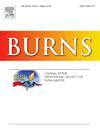The association between body mass index and physical function in adult burn survivors: A Burn Model System National Database study
IF 3.2
3区 医学
Q2 CRITICAL CARE MEDICINE
引用次数: 0
Abstract
Introduction
An area of rehabilitation research in burns is the impact of co-morbidities on disease trajectory. Obesity is a comorbidity of increasing public health concern, but its role remains controversial regarding burn injury and physical recovery. Our aim was to evaluate the association between body mass index (BMI) categories as a measure of obesity at discharge and self-reported physical function (PF) during recovery of adult burn survivors.
Methods
This is a retrospective study on data collected by four major US burn centers, which contribute to the Burn Model System National Database. The data included BMI obtained at hospital discharge and self-reported PF-mobility, using the PROMIS measures assessed at 6, 12, and 24 months after burn. Subjects were classified into weight status categories based on BMI: underweight (BMI <18.5), normal weight (18.5 ≤ BMI <25), overweight (25 ≤ BMI <30), obesity class 1 (30 ≤ BMI <35), obesity class 2 (35 ≤ BMI <40), and obesity class 3 (BMI ≥40). Mixed-effects linear regression models were used to assess the association between BMI categories and PF scores over time, adjusted for patient and injury characteristics.
Results
A total of 496 adult burn patients aged 47 ± 16 years were included, with mean total body surface area (TBSA) burned of 18 ± 19 % and mean BMI at discharge of 28 ± 7 kg/m2. PROMIS PF scores significantly improved over time in the recovery phase after burn (time effect, p < 0.001). Compared to overweight burn patients, normal-underweights exhibited lower PF score by an average of 4.06 units (p = 0.001) but scores increased linearly by an estimated 0.17 units per month (p = 0.01) over the 24 months after discharge. Similarly, compared to overweight burn patients, class 1 obese reported lower PF score by a mean 2.67 units (p = 0.07) but PF increased linearly by 0.15 units per month (p = 0.07) over the 24 months after discharge. These findings were independent of the effects of age at discharge, sex, TBSA burned, and hand and leg burn.
Conclusion
Being overweight was associated with improved and faster recovery of PF scores compared to normal, underweight, and obese burn patients during long-term recovery. Hence, our data suggests that long-term recovery and restoration of PF in adult burn survivors is not compromised by a small excess in body weight.
成年烧伤幸存者的体重指数与身体功能之间的关系:烧伤模型系统国家数据库研究。
导言:烧伤康复研究的一个领域是并发症对疾病轨迹的影响。肥胖症是一种日益受到公众健康关注的合并症,但它在烧伤和身体恢复方面的作用仍存在争议。我们的目的是评估作为出院时肥胖测量指标的体重指数(BMI)类别与成年烧伤幸存者在康复期间自我报告的身体功能(PF)之间的关联:这是一项回顾性研究,研究对象是美国四大烧伤中心收集的数据,这些中心为烧伤模型系统国家数据库做出了贡献。数据包括烧伤后 6、12 和 24 个月出院时获得的体重指数(BMI)和自我报告的身体活动能力(PF-mobility),采用 PROMIS 测量方法进行评估。根据体重指数(BMI)将受试者划分为体重状况类别:体重过轻(BMI 结果:体重过轻);体重过重(BMI 结果:体重过重);体重过重(BMI 结果:体重过重);体重过重(BMI 结果:体重过重):共纳入了 496 名成年烧伤患者,年龄为 47 ± 16 岁,平均烧伤体表总面积 (TBSA) 为 18 ± 19 %,出院时的平均体重指数为 28 ± 7 kg/m2。在烧伤后的恢复阶段,PROMIS PF 评分随着时间的推移有了明显改善(时间效应,p 结论:PROMIS PF 评分与烧伤后恢复阶段的改善速度有关:与正常、体重不足和肥胖的烧伤患者相比,超重患者的 PF 评分在长期恢复过程中得到改善,恢复速度也更快。因此,我们的数据表明,成年烧伤幸存者PF的长期恢复和复原并不会因为体重稍有超标而受到影响。
本文章由计算机程序翻译,如有差异,请以英文原文为准。
求助全文
约1分钟内获得全文
求助全文
来源期刊

Burns
医学-皮肤病学
CiteScore
4.50
自引率
18.50%
发文量
304
审稿时长
72 days
期刊介绍:
Burns aims to foster the exchange of information among all engaged in preventing and treating the effects of burns. The journal focuses on clinical, scientific and social aspects of these injuries and covers the prevention of the injury, the epidemiology of such injuries and all aspects of treatment including development of new techniques and technologies and verification of existing ones. Regular features include clinical and scientific papers, state of the art reviews and descriptions of burn-care in practice.
Topics covered by Burns include: the effects of smoke on man and animals, their tissues and cells; the responses to and treatment of patients and animals with chemical injuries to the skin; the biological and clinical effects of cold injuries; surgical techniques which are, or may be relevant to the treatment of burned patients during the acute or reconstructive phase following injury; well controlled laboratory studies of the effectiveness of anti-microbial agents on infection and new materials on scarring and healing; inflammatory responses to injury, effectiveness of related agents and other compounds used to modify the physiological and cellular responses to the injury; experimental studies of burns and the outcome of burn wound healing; regenerative medicine concerning the skin.
 求助内容:
求助内容: 应助结果提醒方式:
应助结果提醒方式:


